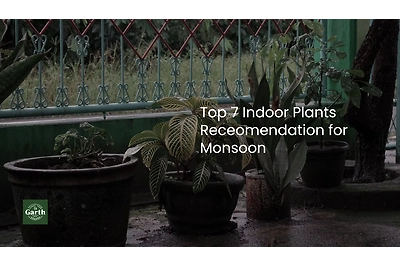Peace Lily: Care Guide with Benefits, Common Problems & Solutions
- 14 May, 2025
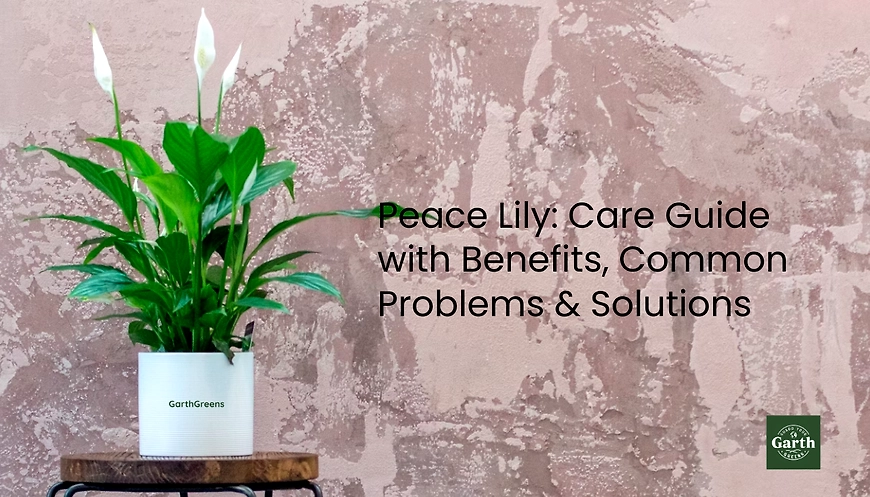
Peace Lily is a lovely, low-maintenance indoor plant that's renowned for air purification and looks lovely wherever you put it.
Whether you prefer to have it at your house or your workplace, Peace Lily is discreet and charming. Let us break down why this plant is so unique, how one can cultivate it, and why it is Garth Green's customer favorite.
Why is a Peace Lily a Good Idea?
Peace Lilies (Spathiphyllum) like to naturally grow in Central and South American tropical rainforests. White flowers and shiny, dark green leaves make them the favorite of all, from homes to offices. Besides the appearance, they have a few other benefits working in their favor.
Why Everyone Loves Them?
- NASA studies have shown that Peace Lilies take away indoor air pollutants like benzene and formaldehyde.
- Do not have to be pampered all the time so that they stay healthy
- Their green sparkling leaves and white spathes, Peace Lilies are ideal in almost any home decor.
- Associated with peaceful and cheerful energy according to Vastu beliefs.
What Vastu Believes Regarding Peace Lilies?
Peace Lilies, in Vastu Shastra, calm the mind and remove mental blockages. People tend to place them:
- In the northeast for clear minds.
- In the workplace, to relieve stress.
- Near doors to create equilibrium.
They also supposedly foster spiritual equilibrium, and therefore, they are a perfect option for an office or home setting.
How to Treat Peace Lilies with Careful Handling:
Peace Lilies are resilient, but even they require careful handling. The following is the best way to have them thrive:
Light Requirements:
- Peace lilies are madly in love with bright, indirect light and can tolerate low light. Keep them away from direct sunlight, however, to prevent leaf scorch.
- They need 12-14 hours of moderate indirect light to bloom; light best between early morning and 10 AM.
- Keep them away from direct sunlight at noon in summer, but in winter, place them close to a light source.
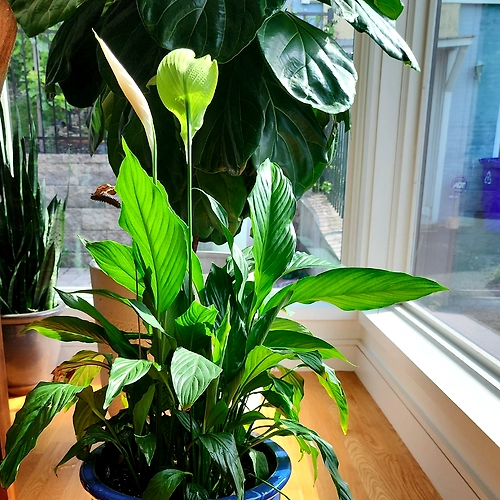
Image Courtesy: Google
Watering Needs and Requirements:
- Water once a week when the topsoil is dry. Do not overwater or underwater.
- Water moderately, 1-2 cups of water for a medium-sized plant, just keep moist but not soggy.
- Water is based on temperature, humidity, and seasons. Water more when the plant is actively growing, and also do not water excessively in the winters so that the roots don't rot.
- Do not use chlorine and any hard mineral water.
Ideal Temperature Range:
- Peace lilies prefer warm and stable temperatures ranging from at least 15°C to a maximum of 29°C.
- Between 19℃ to 26℃ is their optimal growth temperature.
- They are not used to sudden changes in temperature, do not leave them in cold winds and heat waves.
- Provide humidity to prevent drying of leaves.
Soil & Fertilizer:
- Utilize a light, loose, porous loamy soil mix of pine bark and peat moss to promote retention of water as well as air roots. Never use clay soils.
- Change the fresh soil every 6 months and re-pot them every 1 or 2 years as necessary.
- Utilize organic manure such as seaweed extract and compost instead of chemical fertilizer.
Disadvantages of Peace Lilies:
There is no ideal flower. These are some factors:
- The toxin present in peace lilies can harm children and pet animals; it can cause mouth irritation and vomiting.
- Insects like bugs and spiders get attracted by peace lilies.
- They are easily stressed by cold air or direct sun, which causes leaf drop and yellowing.
- This beautiful plant requires high humidity (50% - 60%); wilting and browning of leaves are caused by low humidity.
Common Problems & Solutions:
Why Are Peace Lily Leaves Turning Brown? How to Rescue?
Reason: Inconsistent watering, hard chemical water, or low humidity.
Solution: Increase humidity, water when necessary, and use chemical-free water.
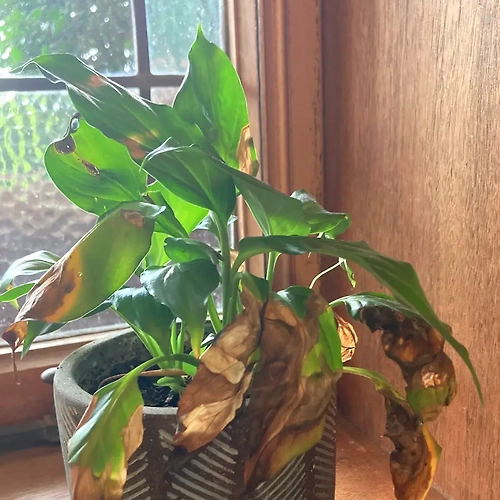
Image Courtesy: GregApp
Why Are Peace Lily Leaves Turning Yellow Tips? How to Rescue?
Reason: Overwatering causes root rot or too little light exposure.
Solution: Place them in light, airy, indirect positions and reduce watering if the soil is wet, and inspect the roots; if they are rotting, trim black, waterlogged roots and re-pot in fresh, dry potting soil.
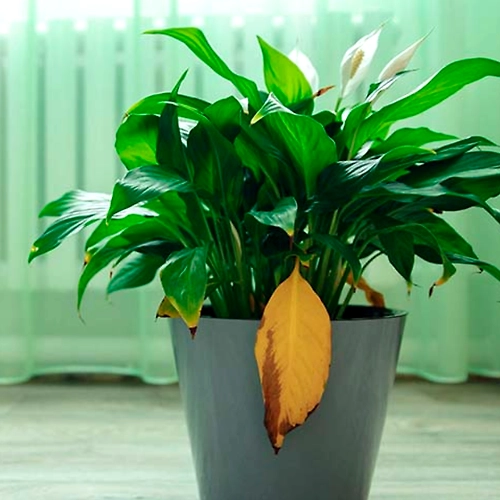
Image Courtesy: Google
Why Are Peace Lily Leaves Turning Black Tips? How to Rescue?
Reason: Fungal disease caused by excess water or cold air exposure.
Solution: Remove the black, infected leaf to stop the fungus from being transferred. Spray houseplants with fungicide. Place them in a room with good air flow, away from cold air, 19℃ - 26℃.
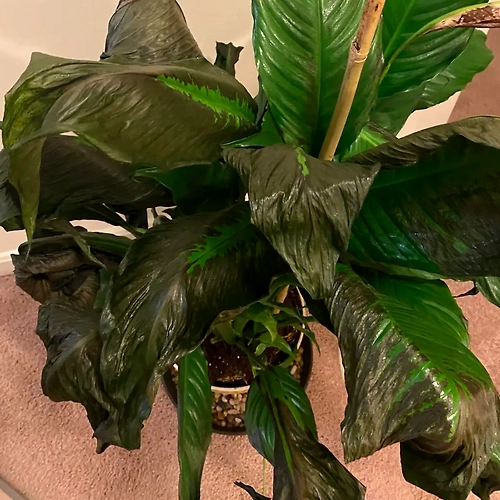
Image Courtesy: Google
Purchase Peace Lilies in Garth Green:
You may well have spotted peace lilies springing up everywhere these days, but at Garth Green, we have:
- Healthier plants in a range of sizes
- Clean, fashionable pots to match any room
- Expert care information and advice
- Peace lilies to fit every budget!
All Peace Lilies that we presently have available for sale are healthy, low-maintenance and lovely, a perfect houseplant for the beginner, as well as the rest of us who know that plants reign supreme!
Shop online or visit our shop and take a look!
A Quick FAQs About Peace Lilies:
1. How do Peace Lilies bloom?
Usually in the spring, and again if you don't overuse them. Give good light, and proper feeding!
2. How frequently do I water them?
Once a week or so is okay, but tap soil. Let dry slightly first.
3. Why are my tips on my Peace Lily turning brown?
Perhaps tap water or low humidity. Filtered water, and try misting the plant.
4. Can you grow Peace Lilies outside?
If by luck, you reside in a warm, frost-free location. Otherwise, place them indoors.
5. How do I wash the leaves?
Wash with a wet cloth. Light can be blocked by dust and plant growth retarded.
6. Can I split them?
Yes. When a pot is too crowded, when you need to repot, divide the plant into more plants.
7. What kind of pot do I require?
Use a pot with drainage holes that will facilitate drainage for excess water and won't hurt roots.
8. Are Peace Lilies Toxic to Pets?
They're not extremely toxic but will scorch pet mouths or make them nauseous. Water-insoluble calcium oxalate crystals make the plant poisonous if chewed. This toxic substance can cause vomiting, discomfort, and drooling in pets.
9. Can I Use Coffee Grounds?
You most likely are familiar with sprinkling grounds on plants' soil. Peace lilies and coffee grounds exist together, but handle them carefully. Used are slightly acidic to the soil, the delight of these plants. Excessive does causes it to grow mold or hard-pack soil. Incorporate them into compost first for the best effect.
10. Is the peace lily toxic to cats?
Yes, and to dogs as well.
Peace Lilies are not just flowers, they are soothing and cleansing companions for the air. If you ever want to relax in your home or office, all you need to do is try them out.
Latest Posts
Contract Production for Bulk Indoor Plants Order
- 31 May, 2025
Jade Plant Care Guide: Everything You Need To Know
- 31 May, 2025
